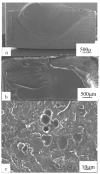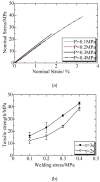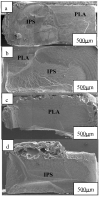Thermal Welding by the Third Phase Between Polymers: A Review for Ultrasonic Weld Technology Developments
- PMID: 32244471
- PMCID: PMC7240386
- DOI: 10.3390/polym12040759
Thermal Welding by the Third Phase Between Polymers: A Review for Ultrasonic Weld Technology Developments
Abstract
Ultrasonic welding (USW) is a promising method for the welds between dissimilar materials. Ultrasonic thermal welding by the third phase (TWTP) method was proposed in combination with the formation of a third phase, which was confirmed as an effective technology for polymer welding between the two dissimilar materials compared with the traditional USW. This review focused on the advances of applying the ultrasonic TWTP for thermoplastic materials. The research development on the ultrasonic TWTP of polycarbonate (PC) and polymethyl methacrylate (PMMA), polylactic acid (PLA) and polyformaldehyde (POM), and PLA and PMMA are summarized according to the preparation of the third phase, welded strength, morphologies of rupture surfaces, thermal stability, and others. The review aimed at providing guidance for using ultrasonic TWTP in polymers and a basic understanding of the welding mechanism, i.e., interdiffusion and molecular motion mechanisms between the phases.
Keywords: thermal welding by the third phase (TWTP); thermoplastic welding technology; ultrasonic welding (USW); welding between dissimilar materials.
Conflict of interest statement
The authors declare no conflict of interest.
Figures
























Similar articles
-
Ultrasonic Welding of Acrylonitrile-Butadiene-Styrene Thermoplastics without Energy Directors.Materials (Basel). 2024 Jul 23;17(15):3638. doi: 10.3390/ma17153638. Materials (Basel). 2024. PMID: 39124302 Free PMC article.
-
Weld Strength of Friction Welding of Dissimilar Polymer Rods Fabricated by Fused Deposition Modeling.Polymers (Basel). 2022 Jun 25;14(13):2582. doi: 10.3390/polym14132582. Polymers (Basel). 2022. PMID: 35808626 Free PMC article.
-
Advances in Ultrasonic Welding of Thermoplastic Composites: A Review.Materials (Basel). 2020 Mar 12;13(6):1284. doi: 10.3390/ma13061284. Materials (Basel). 2020. PMID: 32178404 Free PMC article. Review.
-
The mechanical properties of dissimilar/similar polymer materials joined by friction stir welding.Heliyon. 2023 Jun 24;9(7):e17627. doi: 10.1016/j.heliyon.2023.e17627. eCollection 2023 Jul. Heliyon. 2023. PMID: 37449173 Free PMC article.
-
A Comprehensive Review on Optimal Welding Conditions for Friction Stir Welding of Thermoplastic Polymers and Their Composites.Polymers (Basel). 2021 Apr 8;13(8):1208. doi: 10.3390/polym13081208. Polymers (Basel). 2021. PMID: 33918015 Free PMC article. Review.
Cited by
-
Ultrasonic Welding of PEEK Plates with CF Fabric Reinforcement-The Optimization of the Process by Neural Network Simulation.Materials (Basel). 2023 Mar 6;16(5):2115. doi: 10.3390/ma16052115. Materials (Basel). 2023. PMID: 36903230 Free PMC article.
-
Assembling of Carbon Fibre/PEEK Composites: Comparison of Ultrasonic, Induction, and Transmission Laser Welding.Materials (Basel). 2022 Sep 13;15(18):6365. doi: 10.3390/ma15186365. Materials (Basel). 2022. PMID: 36143674 Free PMC article.
-
Optimizing Ultrasonic Welding Parameters for Multilayer Lap Joints of PEEK and Carbon Fibers by Neural Network Simulation.Materials (Basel). 2022 Oct 6;15(19):6939. doi: 10.3390/ma15196939. Materials (Basel). 2022. PMID: 36234280 Free PMC article.
-
Optimization of Ultrasonic Welding Process Parameters to Enhance Weld Strength of 3C Power Cases Using a Design of Experiments Approach.Polymers (Basel). 2022 Jun 13;14(12):2388. doi: 10.3390/polym14122388. Polymers (Basel). 2022. PMID: 35745966 Free PMC article.
-
Effect of Friction Stir Welding Techniques and Parameters on Polymers Joint Efficiency-A Critical Review.Polymers (Basel). 2021 Jun 23;13(13):2056. doi: 10.3390/polym13132056. Polymers (Basel). 2021. PMID: 34201742 Free PMC article. Review.
References
-
- Red C. The outlook for thermoplastics in aerospace composites, 2014–2023. High Perform. Compos. 2014;22:54–63.
-
- Ajay K., Jayashree B. Investigations on performance and failure mechanisms of high temperature thermoplastic polymers as adhesives. Int. J. Adhes. Adhes. 2016;70:90–101.
-
- Villegas I.F., Moser L., Yousefpour A., Mitschang P., Bersee H.E.N. Process and performance evaluation of ultrasonic, induction and resistance welding of advanced thermoplastic composites. J. Thermoplast. Compos. 2012;26:1007–1024. doi: 10.1177/0892705712456031. - DOI
-
- Kellomaki M., Tormala P. Ultrasonic moulding of bioabsorbable polymers and polymer/drug composites. J. Mater. Sci. Lett. 1997;16:1786–1789. doi: 10.1023/A:1018548130539. - DOI
Publication types
LinkOut - more resources
Full Text Sources

